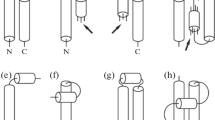Abstract
The main types of structures consisting of adjacent and/or intersecting helices 30/11 formed by tetrahedrally coordinated atoms have been investigated. These structures are fundamentally noncrystalline. Nevertheless, they can take form of regularly folded large helices, lattices, a planar layer, rod structures, and different-level approximations to fractal structures. It is shown that such bound-water structures correspond in metric parameters, symmetry, and topology to crystals of biological macromolecules, protein shells of viruses, and biological tissues. In addition, they can store energy.











Similar content being viewed by others
Notes
Boerdijk–Coxeter helix is a rectilinear helix of E3, in which each four successive vertices form a regular tetrahedron.
REFERENCES
N. A. Bul’enkov, “Possible role of hydration as the leading integration factor in the organization of biosystems at different levels of their hierarchy,” Biofizika. 36 (2), 181–243 (1991) [in Russian].
V. A. Engel’gardt, Cognition of the Phenomena Life (Nauka, Moscow, 1985) [in Russian].
R. Mosseri, D. P. DiVincenzo, J. F. Sadoc, and M. H. Brodsky, “Polytope model and the electronic and structural properties of amorphous semiconductors,” Phys. Rev. B. 32, 3974–4000 (1985). https://doi.org/10.1103/PhysRevB.32.3974
N. A. Bul’enkov, “Periodic dispiration-modular diamond-like structures of “bound” water – possible constructions determining the conformation of biopolymers in the structures of their hydrates,” Sov. Phys.-Crystallogr. 33 (2), 250–261 (1988).
N. A. Bul’enkov, “Self-organization of triplet structures of ideal fractals of “bound” water with symmetries D3 and T,” Sov. Phys.-Crystallogr. 35 (1), 88–92 (1990).
N. A. Bul’enkov, “Parametric fractal-triplet structures of “bound” water in the form of closed surfaces and possibility of supramolecular self-assembly of virus capsules on them,” Sov. Phys.-Crystallogr. 35 (1), 92–95 (1990).
N. A. Bulienkov, “Three possible branches of determinate modular generalization of crystallography,” in Fields Institute Monographs, Vol. 10: Quasicrystals and Discrete Geometry, Ed. by J. Patera (Am. Math. Soc., Providence, Rhode Island, 1998), pp. 67–134.
N. A. Bulienkov and E. A. Zheligovskaya, “Role of bound water and precipitants in the self-organization of biocrystals,” J. Struct. Chem. 55 (7), 1215–1224 (2014). https://doi.org/10.1134/S0022476614070051
E. V. Blagova and I. P. Kuranova, “Crystallization and preparation of protein crystals for X-ray diffraction analysis,” Crystallogr. Rep. 44 (3), 513–531 (1999).
Ya. Levy and J. N. Onuchic, “Water mediation in protein folding and molecular recognition,” Annu. Rev. Biophys. Biomol. Struct. 35, 389–415 (2006). https://doi.org/10.1146/annurev.biophys.35.040405.102134
C. D. Carter, X. He, S. H. Munson, P. D. Twigg, K. M. Gernert, M. B. Broom, and T. Y. Miller, “Three-dimensional structure of human serum albumin,” Science. 244, 1195–1198 (1989). https://doi.org/10.1126/science.2727704
C. D. Carter and X. He, “Structure of human serum albumin,” Science. 249, 302–303 (1990). https://doi.org/10.1126/science.2374930
X. M. Xe and D. C. Carter, “Atomic structure and chemistry of human serum albumin,” Nature. 364, 362 (1993). https://doi.org/10.1038/364362b0
N. A. Bulienkov and E. A. Zheligovskaya, “Functional modular dynamic model of the surface layer of water,” Russ. J. Phys. Chem. 80 (10), 1584–1604 (2006). https://doi.org/10.1134/S0036024406100086
A. Haji-Akbari and P. G. Debenedetti, “Perspective: Surface freezing in water: A nexus of experiments and simulations,” J. Chem. Phys. 147 (6), 060901 (2017). https://doi.org/10.1063/1.4985879
V. M. Kaganer, H. Möhwald, and P. Dutta, “Structure and phase transitions in Langmuir monolayers,” Rev. Mod. Phys. 71 (3), 779–819 (1999). https://doi.org/10.1103/RevModPhys.71.779
E. V. Ermakova, Candidate’s Dissertation in Chemistry (Frumkin Inst. Phys. Chem. Electrochem. RAS, Moscow, 2019).
V. V. Arslanov, L. S. Sheinina, and M. A. Kalinina, “Supramolecular chemistry of highly ordered systems,” in Selected Aspects of Modern Physical Chemistry (Granitsa, Moscow, 2005), pp. 94–118 [in Russian].
N. A. Bulienkov and E. A. Zheligovskaya, “System-forming functions of bound water in the mechanism of topochemical reactions of formation of ultrathin layers on water surface,” Biophysics. 58 (1), 1–18 (2013). https://doi.org/10.1134/S0006350913010041
N. A. Bulienkov, E. A. Zheligovskaya, V. V. Klechkovskaya, and G. I. Ivakin, “Role of the surface layer of water in the self-organization of metal sulfide textures under a Langmuir monolayer,” Crystallogr. Rep. 56 (3), 517–525 (2011). https://doi.org/10.1134/S1063774511020040
V. I. Lobyshev, A. B. Solovei, and N. A. Bulienkov, “Computer modular design of parametric structures of water,” Biophysics. 48 (6), 932–941 (2003).
E. A. Zheligovskaya and N. A. Bulienkov, “Rod structures of bound water: A possible role in self-organization of biological systems and nondissipative energy transmission,” Biophysics. 62 (5), 683–690 (2017). https://doi.org/10.1134/S0006350917050256
N. A. Bulienkov and E. A. Zheligovskaya, “Generalized crystallography and bound-water modular structures determining morphogenesis and size of biosystems,” Struct. Chem. 28 (1), 75–103 (2017). https://doi.org/10.1007/s11224-016-0837-3
N. A. Bulienkov, “The role of modular design in study of the self-organization of biological systems,” Biophysics. 50 (5), 811–831 (2005).
N. A. Bulienkov, “Systemic structural modular generalization of the crystallography of bound water applied to study the mechanisms of processes in biosystems at the atomic and molecular level,” Crystallogr. Rep. 56 (4), 680–697 (2011). https://doi.org/10.1134/S1063774511040043
Author information
Authors and Affiliations
Corresponding author
Additional information
Translated by Yu. Sin’kov
About this article
Cite this article
Zheligovskaya, E.A., Bulienkov, N.A. Structures Consisting of Helices 30/11 and Their Possible Realization in Aqueous Systems. Phys. Wave Phen. 29, 141–154 (2021). https://doi.org/10.3103/S1541308X21020163
Received:
Revised:
Accepted:
Published:
Issue Date:
DOI: https://doi.org/10.3103/S1541308X21020163




